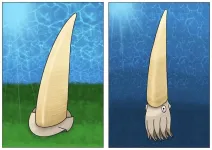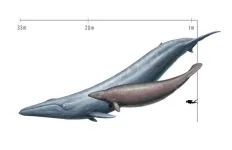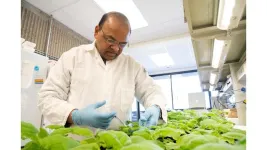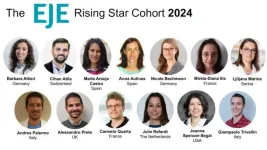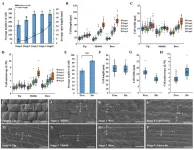(Press-News.org) A team of researchers led by Alexander Pohle has unveiled a treasure trove of ancient fossils from Queensland's Black Mountain. The findings, published in PeerJ Life & Environment, shed new light on the complex three-dimensional siphuncle morphology of Plectronoceratids, a pivotal group of molluscs from the latest Cambrian period.
The study surpasses the entirety of previously documented Plectronoceratid fossils, presenting over 200 well-preserved specimens. These fossils, meticulously collected by the late Mary Wade and her team during the 1970s and 1980s, offer unprecedented insights into the intricate structures of these ancient creatures.
Pohle's team focused on specimens from the lower Ninmaroo Formation at Black Mountain, meticulously examining the three-dimensional morphology of the siphuncle. This comprehensive analysis revealed a remarkably intricate siphuncular structure, challenging previous interpretations based on longitudinal sections and prompting a major revision of the taxonomic classification within the order Plectronoceratida.
Of particular note is the discovery of Sinoeremoceras marywadeae sp. nov., a new species named in honor of Mary Wade. This species, characterized by its highly oblique siphuncular segments and elongated septal neck, represents a significant addition to the cephalopod evolutionary tree. Moreover, the study advocates for a revised taxonomy, consolidating multiple species, genera, families and even one order under the Plectronoceratida.
Pohle expressed his gratitude to Mary Wade, whose dedication to specimen collection and preparation paved the way for this groundbreaking research. "Would it not be for her, these faunas would still largely be unknown," said Pohle. The team hopes that their work honors Wade's legacy, acknowledging the invaluable contributions she made to paleontological science.
As the scientific community delves deeper into the origins of cephalopods, Pohle's team emphasizes the significance of further exploration and advanced imaging techniques. They advocate for the use of 3D reconstructions, such as µCT scans or serial grinding tomography, to unlock new dimensions of understanding in research on Palaeozoic cephalopds.
The publication of this groundbreaking study marks a pivotal moment in our quest to unravel the mysteries of ancient marine life. With each fossil unearthed, we inch closer to a comprehensive understanding of Earth's prehistoric past.
END
Black mountain unveils fossil trove
New revelations poised to reshape our understanding of early cephalopod evolution
2024-02-29
ELSE PRESS RELEASES FROM THIS DATE:
Slimming down a colossal fossil whale
2024-02-29
A 30 million year-old fossil whale may not be the heaviest animal of all time after all, according to a new analysis by paleontologists at UC Davis and the Smithsonian Institution. The new analysis puts Perucetus colossus back in the same weight range as modern whales and smaller than the largest blue whales ever recorded. The work is published Feb. 29 in PeerJ.
A fossil skeleton of Perucetus was discovered in Peru and described in a paper in Nature last year. The animal lived about 39 million years ago and belonged to an extinct group of early whales called ...
Better neutron mirrors can reveal the inner secrets of matter
2024-02-29
Improved neutron mirrors can increase the efficiency of material analysis in neutron sources such as the ESS, which is being built outside Lund, Sweden. The improved mirror has been developed by researchers at Linköping University by coating a silicon plate with extremely thin layers of iron and silicon mixed with boron carbide. Their study has been published in the journal Science Advances.
“Instead of increasing the power on the neutron source, which is extremely expensive, it’s better to focus on improving optics,” says Fredrik Eriksson, researcher at the Thin Film Physics Division at Linköping University.
Together with protons, neutrons ...
Astronomers reveal a new link between water and planet formation
2024-02-29
Researchers have found water vapour in the disc around a young star exactly where planets may be forming.
Water is a key ingredient for life on Earth and is also thought to play a significant role in planet formation, yet, until now, astronomers have never been able to map how water is distributed in a stable, cool disc — the type of disc that offers the most favourable conditions for planets to form around stars.
For the first time, astronomers have weighed the amount of water vapour around a typical planet-forming star.
The new findings were made possible thanks to the Atacama Large Millimeter/submillimeter Array (ALMA) - a collection of telescopes ...
Plant biologists identify promising new fungicides
2024-02-29
A promising new fungicide to fight devastating crop diseases has been identified by researchers at the University of California, Davis. The chemical, ebselen, prevented fungal infections in apples, grapes, strawberries, tomatoes and roses and improved symptoms of pre-existing fungal infection in rice.
Fungal pathogens account for almost a quarter of global crop losses. In the United States, these losses amount to around $150 billion per year. However, fungicide development has been slow for the past 50 years, largely because researchers have had difficulty identifying molecular pathways to target. In a new study published Feb. 29 in ...
Researchers uncover a potential genetic marker associated with better survival outcomes in patients with head and neck cancer
2024-02-29
FINDINGS
Researchers from the UCLA Health Jonsson Comprehensive Cancer Center show for the first time that a gene usually linked to giant axonal neuropathy, a rare and severe neurological condition, also plays a role in inhibiting aggressive tumor cell growth in head and neck cancers.
The team found when the specific genetic variant (GAN gene exon 8 SNP T allele) of the GAN gene isn't present, it leads to the production of certain proteins that make cancer cells more likely to spread and become resistant to treatment.
These findings suggest that the presence of the genetic variant and higher expression of the GAN gene product gigaxonin may contribute ...
European Society for Endocrinology’s European Journal of Endocrinology announces “Rising Stars” in endocrine research for 2024-26
2024-02-29
Thirteen exceptional endocrine researchers from across Europe and the US have been selected as the 2024-26 cohort of the EJE Rising Star Editorial Board by the European Journal of Endocrinology (EJE), a journal published by the European Society of Endocrinology (ESE).
This prestigious opportunity is given to individuals selected by EJE Editors who show promise, achievement and trajectory as leading clinical and translational researchers in endocrinology, with high potential to serve as future editors of EJE.
Through the Rising Stars Programme, awardees are granted the following:
membership ...
Hai-quan Huang's research team at Southwest Forestry University has revealed the cellular and molecular basis of the spur development in Impatiens uliginosa
2024-02-29
As an important reproductive organ of angiosperms, flowers have clear purposefulness and adaptive significance in their various characteristics. As a typical floral evolutionary feature, the floral spur is a tubular structure extending from the petal, which has undergone several independent evolutions in angiosperms (e.g., Impatiens, Aquilegia, Linaria, etc.). Meanwhile, it plays a vital role in the pollination process because of its properties of secreting and storing nectar. In addition, the morphology (length, diameter, degree of distortion), ...
New research reveals that lockdowns had an impact on gut microbes and allergies in newborns
2024-02-29
29 February 2024: Lockdowns imposed during the COVID-19 pandemic had an impact on the gut microbiome development of babies born during these periods according to new research from RCSI University of Medicine and Health Sciences, Children’s Health Ireland and APC Microbiome Ireland (APC), a world leading SFI Research Centre, based in University College Cork.
Our gut microbiome, an ecosystem of microbes that live in our digestive tract, plays an essential role in human health. The study published in Allergy is the first to specifically explore the gut health of newborns in the pandemic. ...
Seeing the wood for the trees: how archaeologists use hazelnuts to reconstruct ancient woodlands
2024-02-29
If we could stand in a landscape that our Mesolithic ancestors called home, what would we see around us? Scientists have devised a method of analyzing preserved hazelnut shells to tell us whether the microhabitats around archaeological sites were heavily forested or open and pasture-like. This could help us understand not only what a local environment looked like thousands of years ago, but how humans have impacted their habitats over time.
“By analyzing the carbon in hazelnuts recovered from archaeological sites in southern Sweden, from Mesolithic hunter-gatherer ...
EU-funded Biodiversity Community Integrated Knowledge Library (BiCIKL) project sums up outcomes and future prospects at a Final GA in Cambridge
2024-02-29
The city of Cambridge and the Wellcome Campus hosted the Final General Assembly of the EU-funded project BiCIKL (acronym for Biodiversity Community Integrated Knowledge Library): a 36-month endeavour that saw 14 member institutions and 15 research infrastructures representing diverse actors from the biodiversity data realm come together to improve bi-directional links between different platforms, standards, formats and scientific fields. Consortium members who could not attend the meeting in Cambridge joined the meeting remotely.
The ...
LAST 30 PRESS RELEASES:
Injectable breast ‘implant’ offers alternative to traditional surgeries
Neuroscientists devise formulas to measure multilingualism
New prostate cancer trial seeks to reduce toxicity without sacrificing efficacy
Geometry shapes life
A CRISPR screen reveals many previously unrecognized genes required for brain development and a new neurodevelopmental disorder
Hot flush treatment has anti-breast cancer activity, study finds
Securing AI systems against growing cybersecurity threats
Longest observation of an active solar region
Why nail-biting, procrastination and other self-sabotaging behaviors are rooted in survival instincts
Regional variations in mechanical properties of porcine leptomeninges
Artificial empathy in therapy and healthcare: advancements in interpersonal interaction technologies
Why some brains switch gears more efficiently than others
UVA’s Jundong Li wins ICDM’S 2025 Tao Li Award for data mining, machine learning
UVA’s low-power, high-performance computer power player Mircea Stan earns National Academy of Inventors fellowship
Not playing by the rules: USU researcher explores filamentous algae dynamics in rivers
Do our body clocks influence our risk of dementia?
Anthropologists offer new evidence of bipedalism in long-debated fossil discovery
Safer receipt paper from wood
Dosage-sensitive genes suggest no whole-genome duplications in ancestral angiosperm
First ancient human herpesvirus genomes document their deep history with humans
Why Some Bacteria Survive Antibiotics and How to Stop Them - New study reveals that bacteria can survive antibiotic treatment through two fundamentally different “shutdown modes”
UCLA study links scar healing to dangerous placenta condition
CHANGE-seq-BE finds off-target changes in the genome from base editors
The Journal of Nuclear Medicine Ahead-of-Print Tip Sheet: January 2, 2026
Delayed or absent first dose of measles, mumps, and rubella vaccination
Trends in US preterm birth rates by household income and race and ethnicity
Study identifies potential biomarker linked to progression and brain inflammation in multiple sclerosis
Many mothers in Norway do not show up for postnatal check-ups
Researchers want to find out why quick clay is so unstable
Superradiant spins show teamwork at the quantum scale
[Press-News.org] Black mountain unveils fossil troveNew revelations poised to reshape our understanding of early cephalopod evolution
